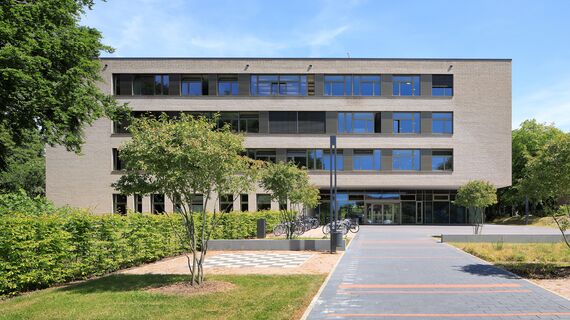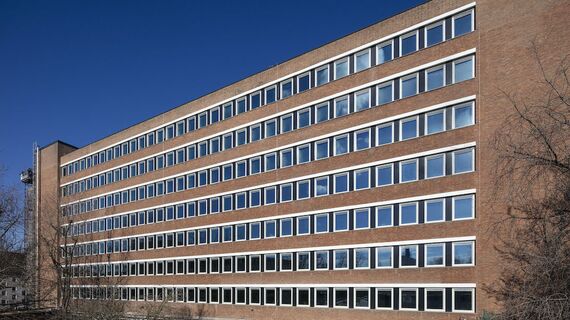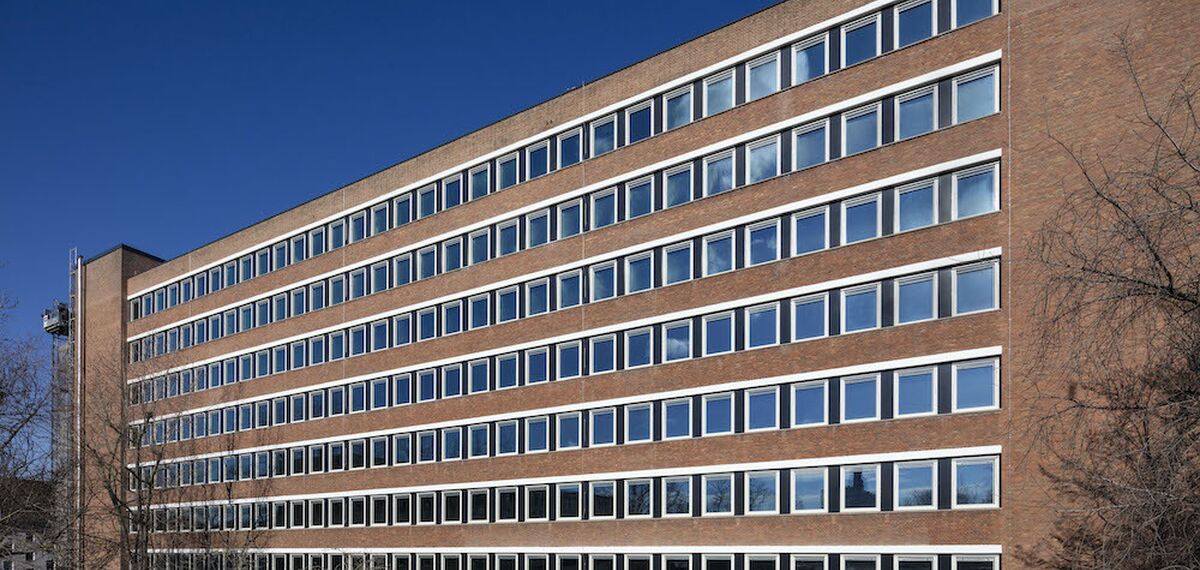
- SSP AG, Bochum
WiSo building at the University of Cologne
With the renovation of the building complex of the Faculty of Economics and Social Sciences, the University of Cologne is facing the challenges typical of the building stock of the 1950s: energy efficiency, fire protection and technical equipment no longer met the demands of a future-oriented location for research and teaching. A particular challenge was posed by preservation requirements, which, in addition to careful handling of the building's fabric, also stipulated retention of the original facade. As part of the facade renovation, around 500 horizontally pivoted windows with Forster steel profile systems were used, which were developed by an interdisciplinary team as functional all-rounders based on a historical model.
500 high-tech windows with protected status
With around 50,000 students, the University of Cologne is one of the largest universities in Germany. In order to remain competitive as a centre of educational in future, the university has drawn up a master plan for the ongoing development and renovation of the existing buildings. The building complex of the Faculty of Economics and Social Sciences (WiSo) is one of the central projects. This is being overhauled as part of a comprehensive renovation programme, with a view to offering optimal conditions for research and teaching. For example, a new extension has already been built in 2019 according to the designs of ksg kister scheithauer gross architekten, while Bochumer SSP AG has been commissioned to renovate the existing buildings.
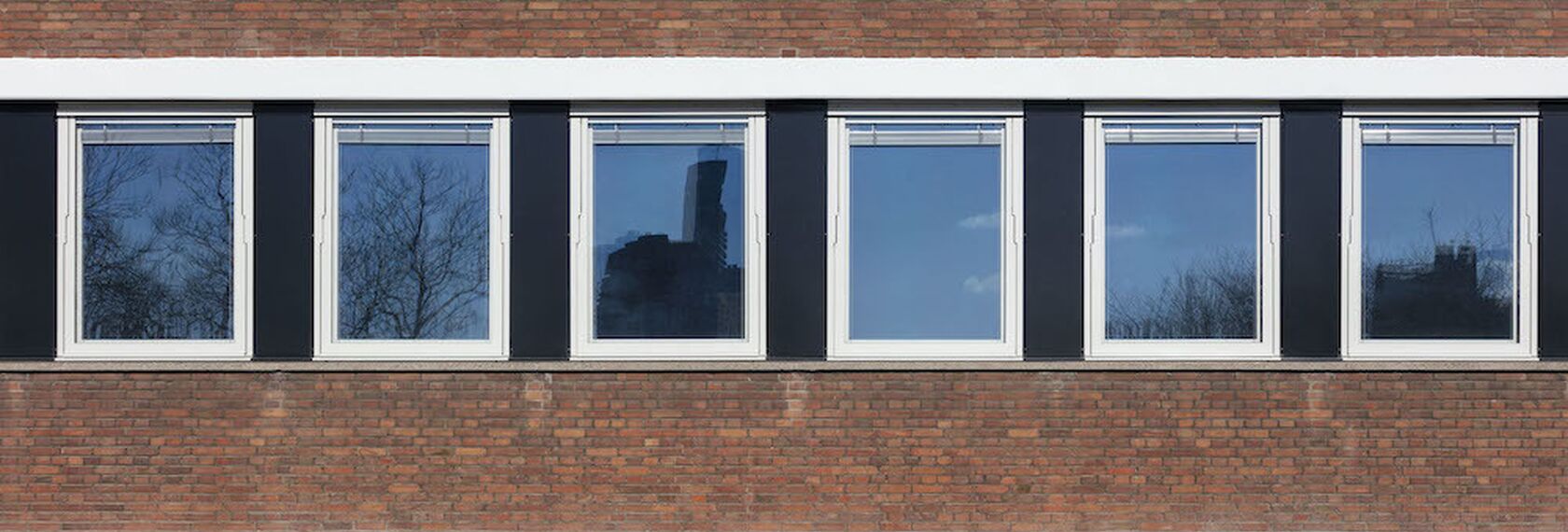
Narrow face widths despite the considerable weight and width of the window boxes: the forster unico steel profile system helps to meet the preservation requirements.
Photos: Jens Kirchner / Forster Profile Systems Ltd
Monument to post-war modernism
The building complex of the WiSo Faculty was designed and built by the Cologne architect Wilhelm Riphahn in the late 1950s. It is a listed structure from the post-war modernist school, where the main building, a high-rise some 83 metres long and nine storeys high,, is the dominant feature at the site on the city's inner green belt. Longitudinal and transverse wings, which contain lecture halls as well as seminar and work rooms, are connected to the high-rise building. Another dominant presence in this urban landscape is the large-scale, single-storey building that forms a kind of base. This incorporates three garden courtyards that provide natural lighting and ventilation for the structure – a design principle that Riphahn also emphasised for the facade of the block in question: around 500 horizontally pivoted windows were used here, which form continuous rows and are a defining feature of the facade's orthogonal, grid-like pattern. Over the years, however, these were replaced by tilt--turn windows, which affected the original heat shield function. The new windows no longer ensured sufficient air circulation to counteract heating of the rooms in summer.
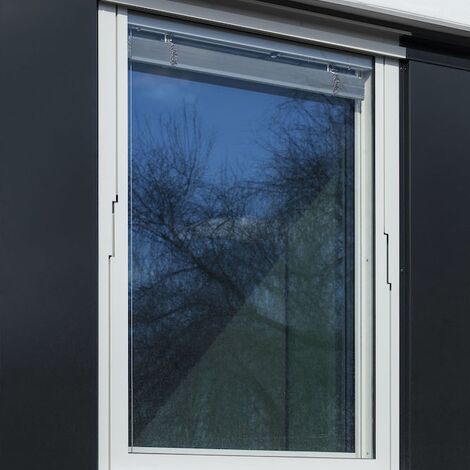
Sensitive to protected status and long-lasting: the forster unico profile system is used with a powder coating in the historical colour and an internal anti-corrosion coating. On the inside, a service sash provides access for maintenance and cleaning of the window box.
Photos: Jens Kirchner / Forster Profile Systems Ltd
Retention of the fabric (in principle)
For the refurbishment of the faculty building, the University of Cologne, as client, insisted on careful handling of the building's fabric, with a view to retain its original structure and materials. Having performed an inventory, the architects from SSP AG found the fabric of the building was in good condition. Three preserved box windows were also found, which were ahead of their time. The horizontally pivoted windows ensure good air circulation in rooms via the upper and lower openings. Shade elements integrated into the interspace of the panes also featured a chain operation for individual adjustment. “The vision was born – of a contemporary take on a pivoted window,” recalls project manager Markus Wessels from SSP AG. “The challenge for us was to deliver a modern version of the window design. And one that would also meet today’s typical buildings requirements in physical terms.”
New version for buildings with protected status
The architects factored preservation into the planning process at an early stage. The choice of window profiles proved to be a challenge: they had to have particularly narrow face widths in order to preserve the appearance of the façade, but also had to accommodate the considerable weight and overall width of the pivoting double window boxes. Forster Profile Systems proved to be the ideal partner for this task, both in terms of its portfolio of window profiles and its experience in developing special solutions. In close cooperation with MTZ-Metalltechnik Zitzmann and daylight planner Dr Helmut Köster, the architects and the Forster team developed a contemporary new version of a historical model, which met both the client's and preservation-related requirements.
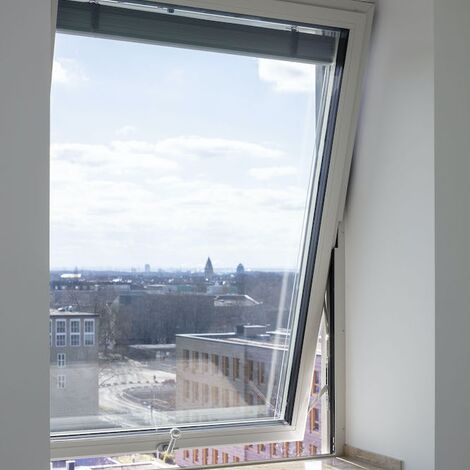
The new version of the horizontally pivoted window, based a historical model, is a true all-rounder: the solution combines natural ventilation with integrated daylight control, electrically controlled sun and glare protection and state-of-the-art energy efficiency.
Photos: Jens Kirchner / Forster Profile Systems Ltd
Windows with complex functionality
The forster unico steel profile system forms the basis of the window frames. Thanks to the high rigidity of the material, the face widths of the new 70 mm pivot horizontally pivoted windows are particularly slim. Special light-deflecting slats from RETROSolar are integrated into the composite box windows. These are around 15 cm wide and provide convenient glare protection without any darkening effect. With the sunlight reflected outwards, any direct incoming heat is also reduced and gtotal is kept below 0.05. However, a sufficient amount of daylight is still channelled into the room, so no additional artificial light is required for ergonomic lighting purposes. Unlike the historical model, the slats are no longer adjusted with a crank handle, but are l controlled electrically based on solar radiation. The side-hung element on the inside, with its triple-insulating glazing, can also be opened for maintenance and cleaning purposes.
Sustainable prospects
After the renovation, the historic buildings at the WiSo Faculty in Cologne will be well equipped for a future with increasingly hot summers thanks to the high energy standards of the new windows. In terms of material used, glass and steel are also pioneering and sustainable: Forster’s particularly durable profiles are made from 100% recyclable steel and do not contain any synthetic insulating materials. This enables clients to live up to their responsibility for future generations and the environment with their natural resources – whether for new buildings or renovating existing buildings.
Involved stakeholders
Architect
- SSP AG, Bochum
Fabricator
- MTZ Metalltechnik Zitzmann GmbH, Oerlenbach
Photographer
- Jens Kirchner, Düsseldorf
Other stakeholder
- University of Cologne (Clients)
- Köster Lichtplanung, Frankfurt am Main (Other)
- RETROSolar Gesellschaft für Tageslichtsysteme mbH, Kirn (Other)
